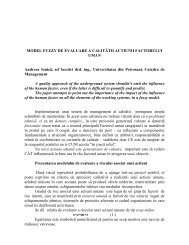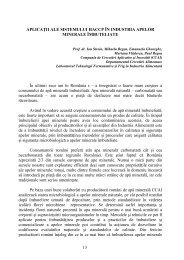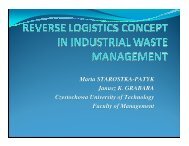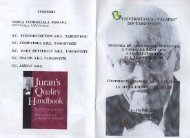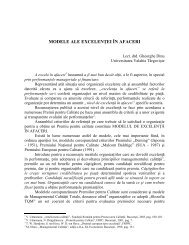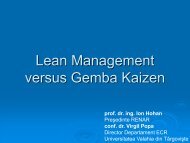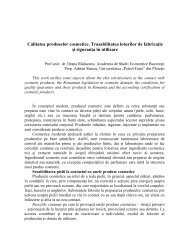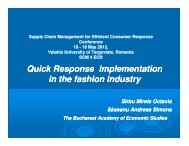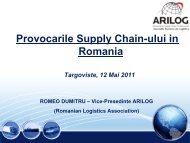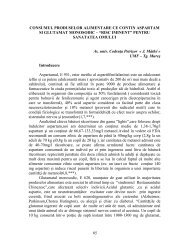SUPPLY CHAIN MANAGEMENT FOR EFFICIENT ... - ecr-uvt
SUPPLY CHAIN MANAGEMENT FOR EFFICIENT ... - ecr-uvt
SUPPLY CHAIN MANAGEMENT FOR EFFICIENT ... - ecr-uvt
You also want an ePaper? Increase the reach of your titles
YUMPU automatically turns print PDFs into web optimized ePapers that Google loves.
<strong>SUPPLY</strong> <strong>CHAIN</strong> <strong>MANAGEMENT</strong><br />
<strong>FOR</strong> <strong>EFFICIENT</strong> CONSUMER<br />
RESPONSE<br />
SYMPOSIUM<br />
11-12 JUNE 2010<br />
TARGOVISTE
SCM 4 ECR SYMPOSIUM<br />
PROJECT <strong>MANAGEMENT</strong> IMPLICATION IN<br />
DEVELOPMENT AND<br />
LAUNCH PROCESSES OF A NEW PRODUCT IN CG<br />
INDUSTRY<br />
Corina DINCA<br />
Virgil POPA
© SCM 4 ECR Corina Dinca, Virgil Popa<br />
“Competing with Everyone from Everywhere for Everything”<br />
Harold SIRKIN, Globality<br />
The rise of both BRIC group( BRAZIL, RUSIA, INDIA, CHINA) and Middle East opposes to the delay<br />
that USA and EUROPE are facing<br />
• Butterfly effect occurs because the today world is more interconnected, more<br />
independent it accentuates its globalized status”.
Need to change<br />
We need some changes, to certain levels, including also systems, practices and<br />
philosophies. Some of the changes are necessary in industry (for example the<br />
application of some global standards), but some could be bilateral affaires between<br />
some commercial partners.<br />
Each company needs to learn what “works for itself”.<br />
Several priorities:<br />
• We need to develop a common vision of the value created by disseminating the<br />
information through all the participants to the value chain. This fact implies the<br />
exact definition of the way in which value can be created both for the<br />
manufacturers and for retailers. A win in information is a win-win strategy, but in<br />
order to succeed, the whole chain must agree on its importance.<br />
• We must agree on what type of information can be disseminated deliberately and<br />
what information is s<strong>ecr</strong>et.<br />
• We need to develop a frame, a schedule that must be approved in industry for the<br />
data that has to be standardized.<br />
• Companies must be prepared to exchange the basic standards, in fact the data,<br />
freely or in return to an available rate of costs recovery. Common standards will<br />
help you minimize the costs of sharing data.<br />
© SCM 4 ECR Corina Dinca, Virgil Popa
• Once we have accepted that the value doesn’t mean rude information, but<br />
analytical capabilities linked to it, we should not regard the share of data as a<br />
revenues engine.<br />
• Security controls must be placed on each platform of information. Trust in<br />
companies, between them, between the companies and the customers, will be<br />
improved only when the information is shared properly.<br />
• The start is simple. Pilots must set up on the available information flows and on<br />
collaboration flows and they must start with the known data and then regard the<br />
unknown data flows.<br />
It is the right time for a radical improvement to the access toward the<br />
information value chain.<br />
© SCM 4 ECR Corina Dinca, Virgil Popa
The new concept development (NCD) construct is a<br />
relationship model, not a linear process.<br />
INFLUENCING FACTORS (THE ENVIRONMENT)<br />
-corporation’s<br />
organizational capabilities<br />
-customer and competitor<br />
influences: Porter’s “five<br />
forces”: (customers,<br />
competitors, new<br />
entrants, suppliers, and<br />
industry rivalry)<br />
-outside world<br />
-depth and strength of<br />
enabling sciences and<br />
technology.<br />
“Enabling” is not the same as “mature”. It is the point when the technology is developed enough<br />
to build it into a manufactured product or regular service offering. Enabling technologies<br />
usually provide some degree of enhanced utility, cost avoidance, value, or quality<br />
improvement for the customer.<br />
Corina Dinca, Virgil Popa
THE ENGINE (LEADERSHIP, CULTURE, AND BUSINESS<br />
STRATEGY)<br />
Leaders demonstrating in every decision and action that innovation is<br />
important to their company.<br />
Encouraging purposeful evolution and encouraging employees to try<br />
new things<br />
Developing real relationship between marketing and technical people<br />
Generating customer intimacy by encouraging their employees to<br />
interact closely with customers.<br />
Engaging the whole organization in understanding that innovation is<br />
the fundamental way that the company brings value to its customers.<br />
Continuing to value the individual and set an environment that is<br />
conductive to high motivation.<br />
OPPORTUNITY IDENTIFICATION<br />
Opportunity identification defines the market or technology arena the company may want to participate in and<br />
allocate its resources.<br />
OPPORTUNITY ANALYSIS<br />
Extensive effort<br />
Opportunity<br />
identification<br />
Customer assessment<br />
© SCM 4 ECR<br />
Strategic framing<br />
Market segment assessment.<br />
Competitor analysis.<br />
Corina Dinca, Virgil Popa
IDEA GENERATION AND ENRICHMENT<br />
The element of idea generation and enrichment concerns the birth, development, and maturation<br />
of a concrete idea.<br />
Ideas are built up, torn down, combined, reshaped, modified, and upgraded.<br />
IDEA SELECTION<br />
Limited information and understanding that are available early in product development makes<br />
idea selection less rigorous in FFE than in the NPD portion, since many ideas must be allowed to<br />
grow and advance.<br />
CONCEPT DEFINITON<br />
Concept definition is the final element of the new concept development model. This element<br />
provides the only exit to the NPD or technology stage gate (TSG)<br />
Guidelines for gatekeepers :<br />
• Objectives<br />
• Fit of the concept with corporate and/or divisional strategies<br />
• Size of opportunity, such as financial impact<br />
• Market of customers needs and benefits<br />
• A business plan that specifies a specific win/win value proposition for value chain<br />
participants<br />
• Commercial and technical risk factors<br />
© SCM 4 ECR<br />
Corina Dinca, Virgil Popa
Feasibility check<br />
Capability check
Efficient Products Introductions – the EPI Wheel<br />
8<br />
ASSESS<br />
LAUNCH<br />
IMPACT ON<br />
CATEGORY<br />
CATEGORY<br />
<strong>MANAGEMENT</strong><br />
PROCESS<br />
1<br />
COLLATE<br />
IDEAS<br />
2<br />
FINALISE<br />
CONCEPT AND<br />
FEASIBILITY<br />
7<br />
EVALUATE<br />
THE JOINT<br />
LAUNCH<br />
6<br />
JOINTLY<br />
COMMUNICAT<br />
E<br />
TO CONSUMER<br />
5<br />
JOINT<br />
EXECUTION<br />
OF LAUNCH<br />
PLAN<br />
3<br />
PRODUCTION<br />
AND MARKET<br />
PLAN<br />
4<br />
PLAN<br />
JOINT<br />
LAUNCH<br />
Source : Courtesy of Ernst & Young<br />
Efficient Product Introductions - The development of value-creating relationships<br />
© SCM 4 ECR Corina Dinca, Virgil Popa
EPI is a comprehensive approach has the greatest potential to create brand and category value as<br />
well as cost savings, but it involves close collaboration between thetrade partners which may or<br />
may not be realistic.<br />
When is a product new?<br />
One reason is that innovation is multi-dimensional-it depends on your perspective.If<br />
you are a manufacturer, for example, you might see it like this:<br />
a new features, changed features and new technology;<br />
a new target users;<br />
a new concept, new marketing mix, new answer to an existing need or to a latent need;<br />
a new organisation/management.<br />
ECR identified Efficient Product Introductions as one of the four Efficient Consumer<br />
Response strategies. The other three pivotal consumer response strategies are:<br />
Efficient Store Assortment, Efficient Replenishment and Efficient Promotion.<br />
CONSUMER VALUE =<br />
( Quality<br />
) ´ ( Trust<br />
( Response<br />
) ´ ( Variety ) ´ ( Service<br />
time ) ´ ( Price )<br />
)<br />
© SCM 4 ECR Corina Dinca, Virgil Popa
The cost of product introductions failures is high .<br />
"Minimum costs": this is money that must be spent on any product introduction. Regardless of the type of product or size<br />
of company, certain minimum activities will have to be performed.<br />
"Additional costs": On top of these minimum activities, companies may choose to invest in additional activities. Many<br />
of the costs thus incurred involve money spent on communicating to the consumer, including advertising and promotion.<br />
For manufacturers such costs normally represent a major share of the total cost of new product introduction.<br />
Activities linked to New Product Introductions<br />
Main Phases Main Activities/Costs Minimum Additional<br />
DEVELOP Market potential analysis ü<br />
Develop prototype for testing /<br />
ü<br />
Market concept test I Product positioning /<br />
ü<br />
Refined market potential analysis I Financial assessment ü<br />
Marketing plan I Trade marketing plan I Merchandising plan<br />
Pilot production run and quality testing<br />
Financial assessment<br />
Discuss high level category plan elements<br />
ü<br />
ü<br />
ü<br />
ü<br />
LAUNCH<br />
Presentation of new product and internal validations<br />
Discuss and agree on new product introduction element:<br />
-Pricing, Distribution, Advertising, ..<br />
-Determine joint promotional plan<br />
ü<br />
ü<br />
Implement coding within system EAN<br />
In store handling activities<br />
Store visits<br />
Advertising and promotions development<br />
Actual advertising<br />
Actual promotion<br />
Actual sampling, etc...<br />
ü<br />
ü<br />
ü<br />
ü<br />
ü<br />
ü<br />
EVALUATE<br />
Asses new product launch (internal)<br />
Discuss evaluation<br />
ü<br />
ü<br />
© SCM 4 ECR<br />
Total costs split into Minimum and Additional
LONG TERM VALUE<br />
Brand/category value generation<br />
© SCM 4 ECR Corina Dinca, Virgil Popa<br />
Innovation<br />
New Product Introduction<br />
BUILT BRAND/<br />
CATEGORY EQUITY<br />
LONG TERM<br />
GROW VOLUME<br />
INCREASE EFFICIENCY<br />
DEVEPLOP BRAND/MARKET<br />
CATEGORY<br />
PENETRATE MARKET<br />
CATEGORY<br />
ENTER NEW SEGMENTS<br />
BRANDS/CATEGORY<br />
CONVERT<br />
NON-USERS<br />
INCREASE<br />
FREQUENCY<br />
ATTRACT<br />
RIVALS’<br />
CUSTOMERS<br />
REDUCE<br />
COSTS<br />
IMPROVE<br />
PRODUCT<br />
PRICE<br />
OFFER<br />
IMPROVE<br />
SALES<br />
MIX
The six improvement areas evaluated<br />
on-going<br />
not always suggested<br />
low difficulty<br />
high difficulty<br />
Planning product<br />
promotions jointly<br />
Aligning new products to<br />
category plans<br />
Developing products<br />
jointly<br />
Distributing products<br />
quickly and efficiently<br />
Evaluating new products<br />
jointly<br />
Financial impact<br />
Implementing in-store<br />
planning promotions<br />
jointly<br />
Revenues<br />
increase<br />
Costs savings<br />
Capital reduction<br />
Courtesy of Ernst &Young<br />
1. Planning product promotions jointly<br />
2. Distributing products quickly and efficiently<br />
3. Implementing in-store product promotions jointly<br />
If both trade partners are involved in implementing the promotional plan<br />
and making rapid changes if necessary marketing mix<br />
efficient consumers more aware more likely to try them.<br />
Volume<br />
Revenue<br />
© SCM 4 ECR Corina Dinca, Virgil Popa
© SCM 4 ECR Corina Dinca, Virgil Popa<br />
4. Aligning new products to category plans<br />
Where a category management process already exists, companies can achieve both revenue and<br />
cost advantages by linking new product introductions into the process.<br />
While manufacturers are already thinking in terms<br />
of category and category planning, they are not<br />
necessarily sharing their thoughts or aligning their<br />
plans with those of retailers.<br />
medium difficulty.<br />
5. Evaluating new products jointly<br />
Agreed launch<br />
objectives earlier on in<br />
the process.<br />
-joint analyze on the role<br />
of advertising, promotion,<br />
packaging, and<br />
positioning of the product<br />
on the shelf and in the<br />
store.<br />
quick response<br />
adjusting the marketing mix<br />
withdrawing the product quickly<br />
Increase revenue, save<br />
costs, working capital<br />
,consumer value
© SCM 4 ECR Corina Dinca, Virgil Popa<br />
6.DEVELOPING PRODUCTS<br />
JOINTLY<br />
High difficulty<br />
Traditionally<br />
Manufacturers who develop<br />
new products<br />
R&D<br />
Competitive<br />
sensitivity<br />
OUTSIDERS<br />
(Retailers)<br />
Other situations<br />
Manufacturers<br />
(niche manufacturers)<br />
NO LARGE R&D<br />
OUTSIDERS<br />
(Retailers)<br />
Low risk<br />
Lower associate costs<br />
& capital<br />
Increased<br />
customer<br />
satisfaction<br />
Improved<br />
product<br />
quality<br />
High
© SCM 4 ECR Corina Dinca, Virgil Popa<br />
A project is a temporary endeavor, having a defined beginning and end (usually<br />
constrained by date), planning deliverables, undertaken to meet unique goals and<br />
objectives.<br />
Project management is the discipline of planning, organizing, and managing resources<br />
to bring about the successful completion of specific project goals and objectives.<br />
When a company reaches a strategic inflection point when his old strategy does not give the<br />
expected results, in an environment where risk IS measurable, but uncertainty NOT, any<br />
performing company chooses the strategic choice of a calculated risk and DOEN’T DO the<br />
mistakes below:<br />
1. Doesn’t dismiss talented people<br />
2. Doesn’t reduce the budget dedicated to technology<br />
3 Doesn’t reduce its assumed risk<br />
4. Doesn’t change performance indicators<br />
5. Doesn’t stop the product development<br />
6. Doesn’t stop the innovation process<br />
Launch a new wine<br />
on French market
© SCM 4 ECR Corina Dinca, Virgil Popa<br />
Vision<br />
The most important mutation that wine demand<br />
has suffered was the switch from a natural and<br />
daily consumption to a hedonistic pleasure. 21th<br />
Century is characterized by CHOERENCE:<br />
- Coherence with history<br />
- Coherence with producers’ and consumers’<br />
experience and potential<br />
- Consistency with market logic<br />
- Product’s consistency: taste, visual and<br />
perceived image
© SCM 4 ECR Corina Dinca, Virgil Popa<br />
Mission:<br />
Mission statement defines the general goal to<br />
exist or to enable the business. It serves as a<br />
guide in times of uncertainty. The mission can<br />
remain the same for several decades if it has<br />
been properly formulated.<br />
Planning is undoubtedly the most important phase<br />
of our project. We reject skepticism when we<br />
mention these pro-planning steps. So we plan :<br />
- To better understand our project<br />
- To understand the most effective way to enforce it<br />
- To communicate exactly how to approach our<br />
customers and consumers<br />
- To actively maintain the flow of progress<br />
- To keep the direction<br />
50% fulfillment of actions DOES NOT MEAN 50%<br />
fulfillment of the project<br />
We do not choose to plan actions, but<br />
"deliverables" - the final products of our project,<br />
whether tangible or intangible
© SCM 4 ECR Corina Dinca, Virgil Popa<br />
Organization values<br />
Values are key priorities in the culture of the organization, including the factors<br />
determining the priorities of its members and how they truly act in the organization.<br />
The three constraints that project management needs to master are presented in the<br />
following scheme:<br />
Destroying values
© SCM 4 ECR Corina Dinca, Virgil Popa<br />
Main objectives :<br />
Specific objectives:
Microsoft Project is a robust tool for projects taking into account the flexibility an<br />
ease of use you need for effective project management.<br />
© SCM 4 ECR Corina Dinca, Virgil Popa
© SCM 4 ECR Corina Dinca, Virgil Popa
© SCM 4 ECR Corina Dinca, Virgil Popa
© SCM 4 ECR Corina Dinca, Virgil Popa<br />
Launched in January 2002, GSMP (Global Standards Management Process) is an<br />
"engine” a process guided by users’ wishes. First facing the Business requirements<br />
phase and then the Technical Development phase it has achieved a standard<br />
specification for data synchronization.<br />
For an unified approach Global Commerce Initiative (GCI) with the consulting<br />
company AC Nielsen has developed a global classification system applicable to all<br />
categories of commercial products. This classification system allows linking to<br />
different schemes:<br />
Article Name 1 2 3 4 5<br />
Brick code 1000000126<br />
Brick name<br />
wine<br />
Attribut 0000010173 0000010055 0000010119 0000010070 0000010012<br />
Attribut name Quality Colour Variety Country Region<br />
Value code 0000011001 0000010219 0000010766 0000010318 0000010092<br />
Value name AOC Red Pinot Noir France Burgundia
Therefore, before implementing RFID tags and readers, all retailers and their suppliers<br />
should adopt the vision of the Global Data Synchronization (GDS) promoted by the<br />
Global Commerce Initiative (GCI) and EAN.UCC. EAN.UCC, standardization<br />
organization for retailers, has developed not only a single standard for identifying<br />
products, Global Trade Identification Number (GTIN), but also infrastructure, Global<br />
Data Synchronization Network (GDSN) to allow retail industry share data easier. Fully<br />
implemented, will allow GDS to access detailed data on any provider’s products<br />
anywhere in the world by any retailer anywhere in the world, through a network database<br />
maintained locally called GTIN on pools.<br />
Electronic product code (EPC)<br />
01 . 0000A89 . 000 I 6 F . 00I69DC0<br />
Header Domain manager Class Serial<br />
8 bits 28 bits 36 bits 24 bits<br />
Determines the next<br />
series of numbers<br />
Identifies the company<br />
or entity responsible<br />
for maintaining the<br />
next number<br />
Used to identify a class<br />
of objects, which is a<br />
product group<br />
Unique identification<br />
of the object<br />
Indicator<br />
character<br />
EAN.UCC prefix Product number Control character<br />
© SCM 4 ECR Corina Dinca, Virgil Popa
For the first time, RFID offers<br />
complete control over the entire flow<br />
of goods. Equipped with a unique<br />
fingerprint, each product can be<br />
recognized and pursued at any point<br />
along the route from producer to<br />
consumer.<br />
Production Packaging<br />
Final Product<br />
Distribution center for goods between warehouses<br />
Point of sale<br />
Customer Information<br />
Purchase / Payment<br />
Complaints / exchange goods<br />
Forecasting / planning supply.<br />
© SCM 4 ECR<br />
Corina Dinca, Virgil Popa
Our ambition should be based on how well we stand up<br />
and mainly on how quick we rise up<br />
Thank you for your attention !<br />
I feel very pleased because I “downloaded”<br />
myself today , and in the meantime I am ready<br />
to fulfill myself again and next time I will<br />
perform better because I will have something<br />
NEW to say!<br />
© SCM 4 ECR Corina Dinca, Virgil Popa




